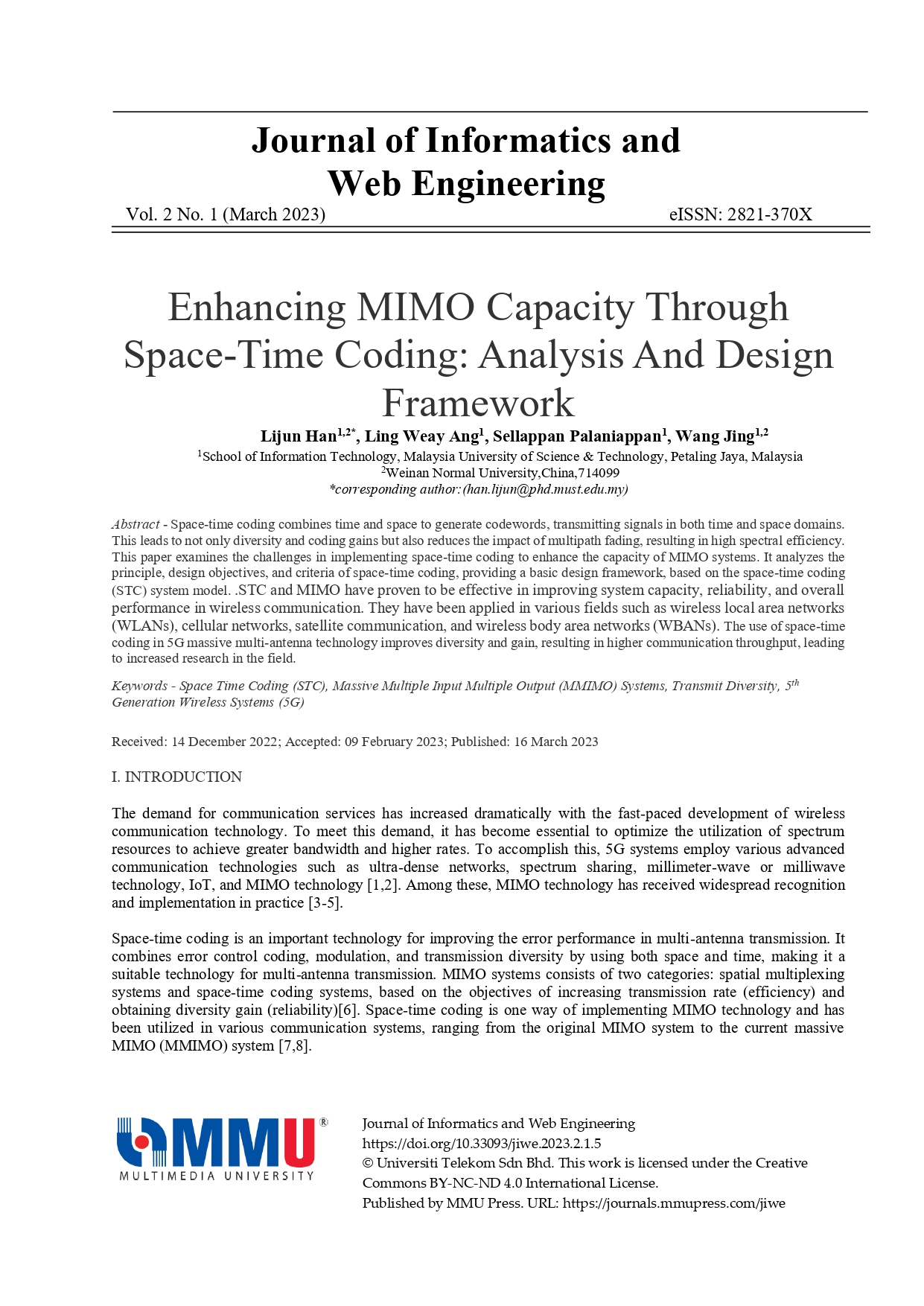Enhancing MIMO Capacity Through Space-Time Coding: Analysis And Design Framework
Main Article Content
Abstract
Space-time coding combines time and space to generate codewords, transmitting signals in both time and space domains. This leads to not only diversity and coding gains but also reduces the impact of multipath fading, resulting in high spectral efficiency. This paper examines the challenges in implementing space-time coding to enhance the capacity of MIMO systems. It analyzes the principle, design objectives, and criteria of space-time coding, providing a basic design framework, based on the space-time coding (STC) system model. .STC and MIMO have proven to be effective in improving system capacity, reliability, and overall performance in wireless communication. They have been applied in various fields such as wireless local area networks (WLANs), cellular networks, satellite communication, and wireless body area networks (WBANs). The use of space-time coding in 5G massive multi-antenna technology improves diversity and gain, resulting in higher communication throughput, leading to increased research in the field.
Article Details

This work is licensed under a Creative Commons Attribution-NonCommercial-NoDerivatives 4.0 International License.
All articles published in JIWE are licensed under a Creative Commons Attribution-NonCommercial-NoDerivatives 4.0 International (CC BY-NC-ND 4.0) License. Readers are allowed to
- Share — copy and redistribute the material in any medium or format under the following conditions:
- Attribution — You must give appropriate credit, provide a link to the license, and indicate if changes were made. You may do so in any reasonable manner, but not in any way that suggests the licensor endorses you or your use;
- NonCommercial — You may not use the material for commercial purposes;
- NoDerivatives — If you remix, transform, or build upon the material, you may not distribute the modified material.
References
M. Chen, W. Saad and C. Yin, “Virtual reality over wireless networks: Quality-of-service model and learning-based resource management”, arXiv, vol. 66, no. 11, pp. 5621–5635, 2017, doi; 10.1109/TCOMM.2018.2850303.
N. Hasan, A.A. Aziz, A. Mahmud, N.A.B. Hamzah and N.Z.A. Rahman, “Localization Techniques Overview Towards 6G Communication”, Journal of Informatics and Web Engineering, vol. 1, no. 1, pp. 28-39, 2022.
N. Zarifeh, A. Kabbani, M. El-Absi, T. Kreul and T. Kaiser, “Massive MIMO exploitation to reduce HARQ delay in wireless communication system”, IEEE Middle East Conference on Antennas and Propagation (MECAP), pp. 1-5, 2016, doi: 10.1109/MECAP.2016.7790122.
E. G. Larsson, O. Edfors, F. Tufvesson and T. L. Marzetta, “Massive MIMO for next generation wireless systems”, IEEE Communications Magazine, vol. 52, no. 2, pp. 186-195, 2014, doi: 10.1109/MCOM.2014.6736761.
L. Lu, G. Y. Li, A. L. Swindlehurst, A. Ashikhmin and R. Zhang, “An Overview of Massive MIMO: Benefits and Challenges”, IEEE Journal of Selected Topics in Signal Processing, vol. 8, no. 5, pp. 742-758, 2014, 10.1109/JSTSP.2014.2317671.
R. Chataut and R. Akl, “Massive MIMO systems for 5G and beyond networks—overview, recent trends, challenges, and future research direction”, Journal of Sensors, vol. 20, no. 10, 2753, 2020, doi: 10.3390/s20102753.
O. Erunkulu, A. M. Zungeru, C. K. Lebekwe, M. Mosalaosi and J. M. Chuma, “5G Mobile Communication Applications: A Survey and Comparison of Use Cases”, IEEE Access, vol. 9, pp. 97251-97295 ,2021, doi : 10.1109/ACCESS.2021.3093213.
X. Ke, S. Yang, J. Wu, and Y. Sun, “Research progress in wireless optical MIMO technology and space-time coding”, Journal of Hunan University of Science and Technology, vol. 42, no.5, pp. 25-32, 2021.
M. Pant, and L. Malviya, “Design, developments, and applications of 5G antennas: a review”, Journal of Microwave and Wireless Technologies, vol. 5, no.1, pp. 1-27, 2022, doi: 10.1017/S1759078722000095.
M. Kamel, W. Hamouda, and A. Youssef, “Ultra-dense networks: A survey”, IEEE Communications Surveys & Tutorials, vol.18, no. 4, pp. 2522-2545, 2016, doi: 10.1109/COMST.2016.2571730.
A. Attarkashani, W. Hamouda, J. M. Moualeu, and J. Haghighat, “Performance Analysis of Turbo Codes and Distributed Turbo Codes in Buffer-Aided Relay Systems”, IEEE Transactions on Communications, vol. 67, no. 7, pp. 4620-4633, 2019.
V. Tarokh, N. Seshadri, and A. Calderbank, “Space-time codes for high data rate wireless communication: performance criterion and code construction”, IEEE Transactions On Information Theory, vol. 44, no. 2, pp. 744-765,1998, doi: 10.1109/18.661517.
E. Telatar, “Capacity of multi-antenna Gaussian channels”, European transactions on telecommunications, vol. 10, no.6, pp. 585--595,1999.
V. Hendre, M. Murugan, and A.B. Chandgude, “Multiple Transmit Antenna Selection in MIMO-OSTBC System in Nakagami-m Fading Channel”, Journal of Procedia Computer Science, vol. 54, pp. 558-565, 2015, doi: 10.1016/j.procs.2015.06.064.
S. M. Alamouti, “A simple transmitter diversity scheme for wireless communications”, IEEE Journal on Selected Areas in Communications, vol. 16, no. 8, pp. 1451-1458,1998.
B. Vucetic and J. Yuan, “Space-time coding”, Chichester: John Wiley and Sons, pp. 66-70, 2003.
E.G. Larsen and P. Stoka, “Space-Time Block Coding for Wireless Communications”, Xi'An Jiao Tong University Press, pp.32-41, 2006.
V. Tarokh, H. Jafarkhani and A. R. Calderbank, “Space-time block codes from orthogonal designs”, IEEE Transactions on Information Theory, vol. 45, no.5, pp. 1456-1467, 1999,doi: 10.1109/18.771146.
B. Qian and W.H. Mow, “A Trellis Error Modeling Approach to Decoding Distributed Turbo Codes”, IEEE Transactions on Wireless Communications, vol. 16, no. 8, pp. 4894-4907, 2017.
I.M.M. de Souza, M.L.M.G. Alcoforado, V.C. da Rocha Jr, “Turbo decoding of simple product codes in a two user binary adder channel employing the Bahl-Cocke-Jelinek-Raviv algorithm”,Journal of Telecommunication Systems, vol. 68, no. 3, pp. 513-521, 2017.
O. Bialer, D. Raphaeli and A. J. Weiss, “Maximum-likelihood direct position estimation in dense multipath”, IEEE Trans. Veh. Technol, vol. 62, no. 5, pp. 2069–2079, 2013.
C. Li, “Implementation of a high-performance OFDM MIMO System model”, Journal of Electronic Information Warfare Technology, vol. 37, no. 3, pp. 57-62, 2022.
A. Attarkashani, W. Hamouda, J. Moualeu, and J. Haghighat, “Performance Analysis of Turbo Codes and Distributed Turbo Codes in Buffer-Aided Relay Systems” ,IEEE Transactions On Communications, vol. 67,no. 7, pp. 4620-4633, 2019.
S. Naima, F. Debbat, and B.F. Tarik, “Performance Improvement of MIMO-OSTBC System with BCH-TURBO Code in Rayleigh Fading Channel”, Journal of Electrical Engineering And Computer Science, vol. 11, pp. 898-907, 2018, doi: 10.11591/ijeecs.v11.i3.pp 898-907.

